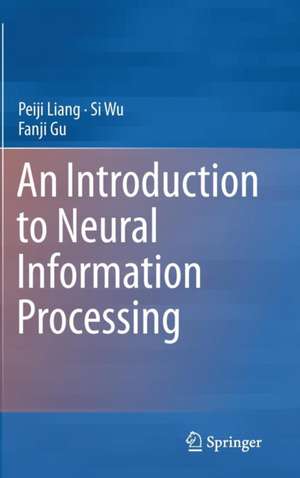An Introduction to Neural Information Processing
Autor Peiji Liang, Si Wu, Fanji Guen Limba Engleză Hardback – 6 ian 2016
| Toate formatele și edițiile | Preț | Express |
|---|---|---|
| Paperback (1) | 946.72 lei 6-8 săpt. | |
| SPRINGER NETHERLANDS – 31 mar 2018 | 946.72 lei 6-8 săpt. | |
| Hardback (1) | 952.72 lei 6-8 săpt. | |
| SPRINGER NETHERLANDS – 6 ian 2016 | 952.72 lei 6-8 săpt. |
Preț: 952.72 lei
Preț vechi: 1161.85 lei
-18% Nou
Puncte Express: 1429
Preț estimativ în valută:
182.32€ • 197.98$ • 153.15£
182.32€ • 197.98$ • 153.15£
Carte tipărită la comandă
Livrare economică 23 aprilie-07 mai
Preluare comenzi: 021 569.72.76
Specificații
ISBN-13: 9789401773911
ISBN-10: 9401773912
Pagini: 328
Ilustrații: XI, 328 p. 210 illus., 45 illus. in color.
Dimensiuni: 155 x 235 x 21 mm
Greutate: 0.65 kg
Ediția:1st ed. 2016
Editura: SPRINGER NETHERLANDS
Colecția Springer
Locul publicării:Dordrecht, Netherlands
ISBN-10: 9401773912
Pagini: 328
Ilustrații: XI, 328 p. 210 illus., 45 illus. in color.
Dimensiuni: 155 x 235 x 21 mm
Greutate: 0.65 kg
Ediția:1st ed. 2016
Editura: SPRINGER NETHERLANDS
Colecția Springer
Locul publicării:Dordrecht, Netherlands
Public țintă
ResearchCuprins
Introduction.- Neurobiological basis underlying neural information processing.- Single neuron models.- Neural Coding.- Neural information processing in different brain areas.- Network models of neural information processing.
Recenzii
“The book is well organized, leading as it does from the physical system being observed to the lowest level, then up to circuits and networks, along the way describing various models that attempt to describe the behavior of the physical system. … The book should be of interest to anyone interested in the current state of neuroscience. It covers quite a bit of ground in a concise but readable manner.” (G. R. Mayforth, Computing Reviews, computingreviews.com, June, 2016)
Notă biografică
Peiji Liang is a professor from Shanghai Jiaotong University. She is council member for both Chinese Neuroscience Society and Chinese Biophysics Society. She also served as the chair of the Computational Neuroscience and Neural Engineering Branch of Chinese Neuroscience Society. She is an associate editor-in-chief for Acta Biophysica Sinica and member of editorial board for Acta Physiologica Sinica. Her current research interest is focused on retinal information processing, particularly the spatial and temporal characteristics of population ganglion cells’ activity in encoding and transmitting the visual information, via both experimental and computational approaches. Prof. Liang is active in the academic and published more than 40 original research papers.
Si Wu is a professor from Beijing Normal University. He is the member of editorial board for Neural Networks and Cognitive Neurodynamics. His research is focused on neural population coding, continuous attractor neural networksand neural information processing with dynamical synapses. He has published more than 50 original research papers.
Fanji Gu is an emeritus professor from Fudan University. He is an honorary member of the governing board of Shanghai Society for Nonlinear Science and one of the honorary chairpersons of the international conference on cognitive neurodynamics. His continuing research work on neural information processing has won Science and Technology award, awarded by Nationa
l Education Adminisration, for four times in 1988, 1995, 1997 and 1999 respectively.Textul de pe ultima copertă
This book provides an overview of neural information processing research, which is one of the most important branches of neuroscience today. Neural information processing is an interdisciplinary subject, and the merging interaction between neuroscience and mathematics, physics, as well as information science plays a key role in the development of this field. This book begins with the anatomy of the central nervous system, followed by an introduction to various information processing models at different levels. The authors all have extensive experience in mathematics, physics and biomedical engineering, and have worked in this multidisciplinary area for a number of years. They present classical examples of how the pioneers in this field used theoretical analysis, mathematical modeling and computer simulation to solve neurobiological problems, and share their experiences and lessons learned. The book is intended for researchers and students with a mathematics, physics or informatics background who are interested in brain research and keen to understand the necessary neurobiology and how they can use their specialties to address neurobiological problems. It is also provides inspiration for neuroscience students who are interested in learning how to use mathematics, physics or informatics approaches to solve problems in their field.
Caracteristici
Clearly illustrates neural information processing models at different levels from single cell to the network Provided with ample illustrations Written by experts in this field?













